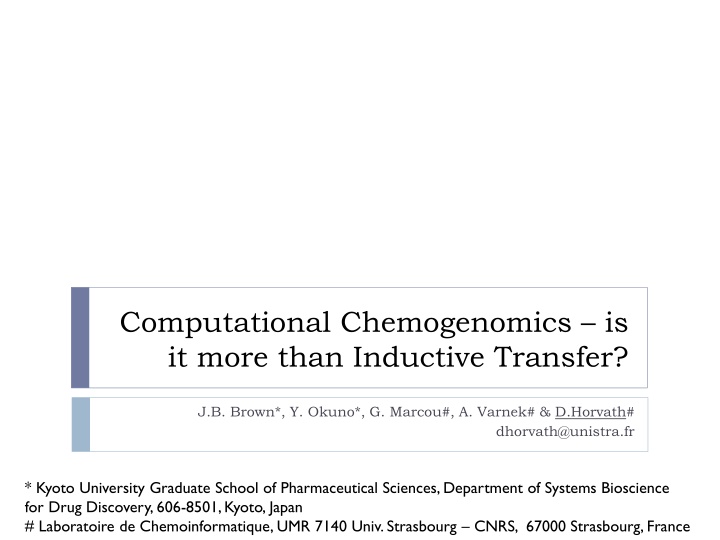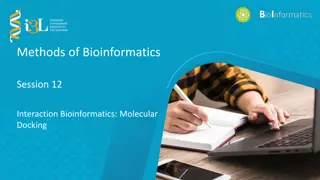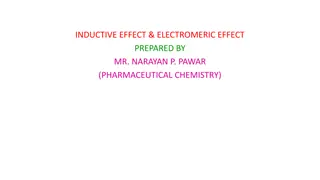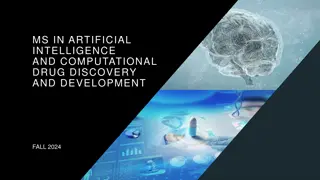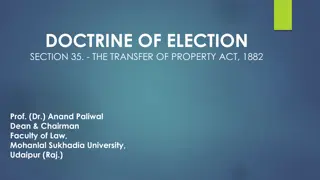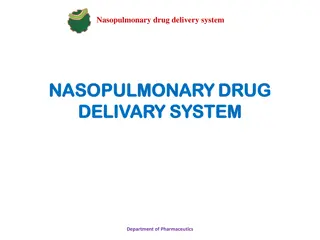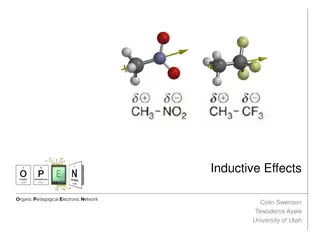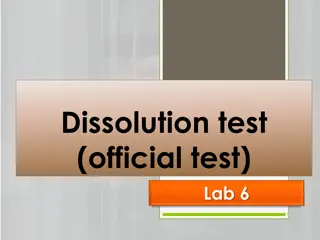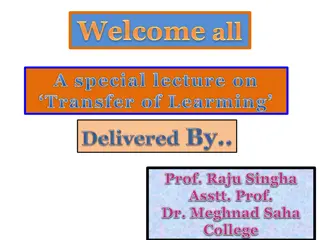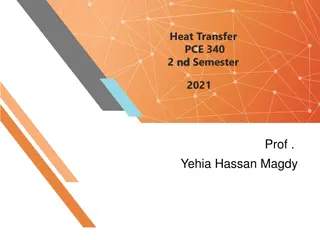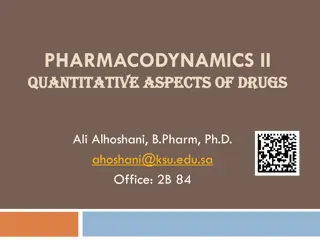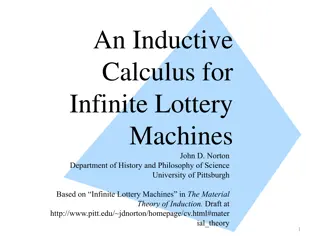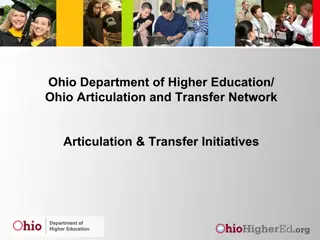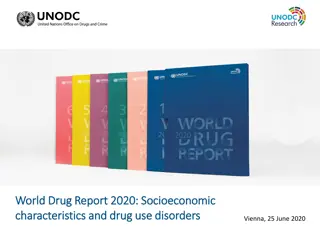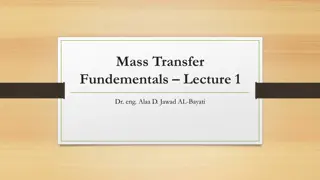Computational Chemogenomics: Inductive Transfer vs. In Silico Drug Discovery
This article by J.B. Brown et al. explores the relationship between computational chemogenomics and inductive transfer in drug discovery. The authors discuss the nuances of leveraging data-driven approaches and machine learning in predicting molecular interactions and drug-protein interactions, highlighting the potential for innovative methodologies in pharmaceutical research.
Download Presentation

Please find below an Image/Link to download the presentation.
The content on the website is provided AS IS for your information and personal use only. It may not be sold, licensed, or shared on other websites without obtaining consent from the author.If you encounter any issues during the download, it is possible that the publisher has removed the file from their server.
You are allowed to download the files provided on this website for personal or commercial use, subject to the condition that they are used lawfully. All files are the property of their respective owners.
The content on the website is provided AS IS for your information and personal use only. It may not be sold, licensed, or shared on other websites without obtaining consent from the author.
E N D
Presentation Transcript
Computational Chemogenomics is it more than Inductive Transfer? J.B. Brown*, Y. Okuno*, G. Marcou#, A. Varnek# & D.Horvath# dhorvath@unistra.fr * Kyoto University Graduate School of Pharmaceutical Sciences, Department of Systems Bioscience for Drug Discovery, 606-8501, Kyoto, Japan # Laboratoire de Chemoinformatique, UMR 7140 Univ. Strasbourg CNRS, 67000 Strasbourg, France
The Challenge of Polypharmacology.. Magic Bullet paradigm is wishful thinking: a drug will not interact only with the target is was designed for . Polypharmacology (knowing all possible drug-biomolecule interactions) is necessary unfortunately not sufficient to understand the in vivo effects of a drug. How does chemoinformatics live up to this challenge? Ligands/Targets L l T t ??? ???????? ?? ? ???? ??????? ?? ?
Chemogenomics = QSAR of Protein- Ligand Complexes 1(T1) 2(T1) p(T1) 1(T1) 2(T1) p(T1) 1(T2) 2(T2) p(T2) pK(L1@T1) pK(L2@T1) pK(Lm@T2) pK(Lm+1@T2) D1(Lm+1) D2(Lm+1) Dk(Lm+1) 1(T2) 2(T2) p(T2) pK(Lq@Tt) D1(Lq) D2(Lq) D1(L1) D1(L2) D1(Lm) D2(L1) D2(L2) D2(Lm) Dk(L1) Dk(L2) Dk(Lm) 1(Tt) 2(Tt) p(Tt) Dk(Lq) ChemoGenomics (CG) Model Ligands/Targets L l T t ?? ?@? ?? ?@? ?? ?@? ?? ?@?
The Ideal of Chemogenomics: Explicit Learning (EL) powered by target information Activity is a function of ligand structural features (encoded by descriptors ?). The relative importance ??,?of a ligand feature i on a target T depends on the active site properties of T. Explicit Learning: attempting to understand how the importance of a ligand feature depends on protein descriptors ??,?= ?? (?) The naive alternative to CG: learning individual QSAR models for each target T: ??? = ?0+ ?1?1? + ?2?2? + +????? where ?[?],?are implicilty dependent on the protein, because they were fitted on the basis of ligand affinity data for T but they have no explicit awareness of the target. Enables Model Building for OrphanTargets! Deorphanization
Yet, inter-target Inductive Transfer (IT) of knowledge may also boost CG An alternative benefit in CG calculations may come from Inductive Transfer (IT) of knowledge between related targets: ??? = ?1?1? + ?2?2? + +????? : n=10, 300 data points ??? = ????? + ?2?2? + +????? : n=10, 7 data points ?? data-poor targets, but does not allow deorphanization! Robustifies models for If enough data points exist to build a robust model for affinity of target T, supplementary data will be needed only to learn the difference betweenT and t: ??? = ??? + ?1 ?1?1? : n=1, 7 data points
The Question: Which is the dominant boost factor in CG: EL or IT? You cannot know this by simply analyzing the machine learning algorithm: procedures allegedly operating in EL mode, provided with protein descriptors, may also be used in IT mode, if target indicator variables are employed instead. In absence of relevant protein descriptors, the best one may hope for is IT enhancement,but It is not clear whether, in presence of protein descriptors, these will be actually employed to build EL-models. What if protein descriptors act as nothing more but sophisticated indicator variables?
How do we address this Question? By benchmarking of the relative performances of Classical single-endpoint QSAR Single-endpoint IT-enhanced QSAR IT-enhanced CG EL-enabled CG,with actual and quasi-ideal protein descriptors Data set: 31 GPCRs from ChEMBL, each associated to >50 ligands of known pKivalue (no arbitrary decoys). Model building: Genetic-Algorithm-tuned Support Vector Regression (libsvm), optimizing operational parameters (kernel type,cost,gamma,etc.) Benchmark includes two predictive challenges: Cross-validated prediction propensity Target deorphanization the key test for genuine EL models!
Descriptors For ligands: ISIDA property-labeled sequence counts (aabPH02, seqPH37, treeSY03, treePH03) & fuzzy pharmacophore triplets (FPT1) Choice of the optimal descriptor space is part of the SVR algorithm tuning process, together with kernel, epsilon, gamma parameter choice. treePH03 turned out to be the consensus descriptor space. For proteins: (IT -CG): Identity Fingerprints IDFP: bitstring of size NTwith one single bit set:the current target. (EL) Similarity Fingerprint SIMFP of size NT,SIMFPT(t) = covariance of pKivalues for t and T, over common ligands quasi-ideal, because they capture actual functional relatedness! (EL) ProFeat terms &Aminoacid sequence snippet counts
Benchmarking Baseline: Classical QSAR (a) BQSAR: Best QSAR, stands for ligand descriptor selection; (b) QSAR in consensus descriptor space treePH03; (c) FQ: Family QSAR, all ligands of all targets confounded, with no target information. L ligand, T Target, D ligand descriptors. Circumflex cap: predicted affinity, Tilda: cross- validated prediction for affinity
IT-Enhanced Strategies (a) SE-IT (Strong Explicit Inductive Transfer) uses predicted BQSAR affinities of other targets as new descriptors. (b) WE-IT (Weak Explicit IT) uses cross-validated BQSAR affinities as new descriptors,
IT-Enhanced Chemogenomics IT-CG learns from the entire profile, concatenating target label info (IDFP) to ligand descriptors
EL-Enabled strategies. Three different models ELSim,ELP and ELSeq,using protein =(SIMFP, ProFeat and sequence respectively,concatenated to the treePH03 ligand terms. count descriptors),
Yes, CG works: XV-RMS errors of many targets with smaller training sets decrease! yet, pure ID-driven enhancement is often nearly as strong as assumed EL benefit.
Cross-Validated Prediction Challenge: EL and IT similar in Strategy Space Map. Correlation coefficients of prediction residuals at per-target and per-item levels, respectively
Deorphanization by substitution use a model of a training set target!
EL- and IT-CG only incidentally fare better than substitution !
Conclusions Herein reported CG simulations are state-of-the-art results, comparing favorably to published work at largely more challenging benchmarking conditions. They confirm the advantage of CG over classical QSAR, Yet, they show that this advantage is clearly due to IT effects,not due to EL Therefore, CG methods are deorphanization not more than mere substitution with a model of a related target. Battle is not lost: perhaps better protein descriptors will trigger a clearly visible EL effect ?! For more details, please check J. Comput.-Aided Mol. Des. 2014, 28 (6), 597-618 not effective in target
Acknowledgements J.B. Brown and Y. Okuno wish to acknowledge support from the following sources: (1) Financial support from Chugai Pharmaceutical Co., Ltd. and Mitsui Knowledge Co., Ltd. (2) Japan Science and Technology Agency CREST program for big data and (3) Japanese Society for the Promotion of Science Kakenhi(B) 25870336 All authors wish to thank the Japanese Society for the Promotion of Science for supporting this collaboration
